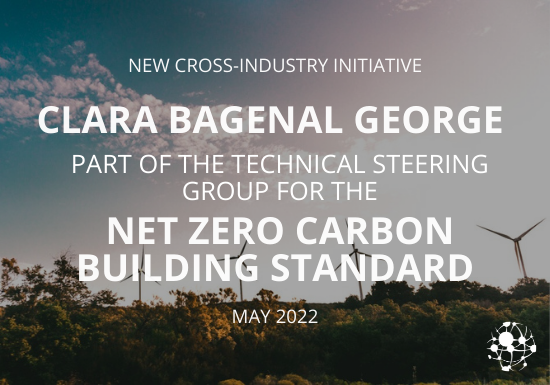Clara Bagenal George chair of the technical steering group for the Net Zero Carbon Building Standard

A cross-industry initiative has been launched to develop the UK’s first Net Zero Carbon Buildings Standard. Leading industry organisations BBP, BRE, the Carbon Trust, CIBSE, IStructE, LETI, RIBA, RICS, and UKGBC have joined forces to champion this initiative.
Whilst significant progress has been made in defining what ‘net zero’ means for buildings in the UK, a process of market analysis showed a clear demand for a single, agreed methodology. The UK Net Zero Carbon Buildings Standard will enable industry to robustly prove their built assets are net zero carbon and in line with our nation’s climate targets.
Associate Clara Bagenal George is the chair of the technical steering group for the new Standard. Clara states:
“The built environment is responsible for a huge proportion of carbon emissions, we are at a tipping point in our ability to reduce the impacts of the climate crisis. I believe that this project will be the key to unlocking a clear, workable path for the built environment to transition to net zero. Not only will this project deliver much-needed clarity on how to verify net zero carbon buildings in the UK, but it also brings together key organisations that have been working in this space, to create a robust, industry-led UK Net Zero Carbon Buildings Standard, created through consensus and collaboration based on science. If you are a built environment professional, I urge you to get involved in any way you can.”
More detail on the UK Net Zero Carbon Buildings Standard
What will it cover?
The Standard will set out metrics by which net zero carbon performance is evaluated, as well as performance targets, or limits, that need to be met. These are likely to include energy use, upfront embodied carbon, and lifecycle embodied carbon, with other metrics – such as space heating/cooling demand and peak load – also to be considered. It will also cover the approach to carbon accounting, procuring renewable energy, and the treatment of residual emissions, including carbon ‘offsetting’. However, the scope and output of the Standard may evolve throughout the development process.
It is expected that claims will be required to be validated based on in-use measured data and interim verification of an asset at design stage or once the asset is built but not yet operating may also be considered.
Who is it for?
The output will be for developers, contractors, asset owners and managers, occupiers, investors, financiers and funders, consultants, building industry professionals, building managers and product/material manufacturers, suppliers, and distributors. It is for anyone who wants to either fund, procure, design, or specify a Net Zero Carbon Building and anyone wanting to demonstrate that their building is ‘Net Zero’-aligned with an industry-agreed Standard.
Will it be science-based?
Performance targets will align with science-based trajectories needed to achieve net zero by 2050 and a 78% reduction by 2035 in the UK, i.e. what is known to be required to stand a reasonable chance of mitigating global warming to 1.5°C. It will also align with the energy demand reductions projected to be required to enable a net zero carbon energy supply sector.
What building types will it apply to?
The approach will be applicable to both existing and new buildings (e.g. Homes, Offices, Education, Industry, Retail, Hotels, Healthcare etc.). To start, the focus will be on the most common building typologies, especially those for which industry stakeholders have already robust performance data available to inform the setting of performance targets. The Standard will not apply to infrastructure.
